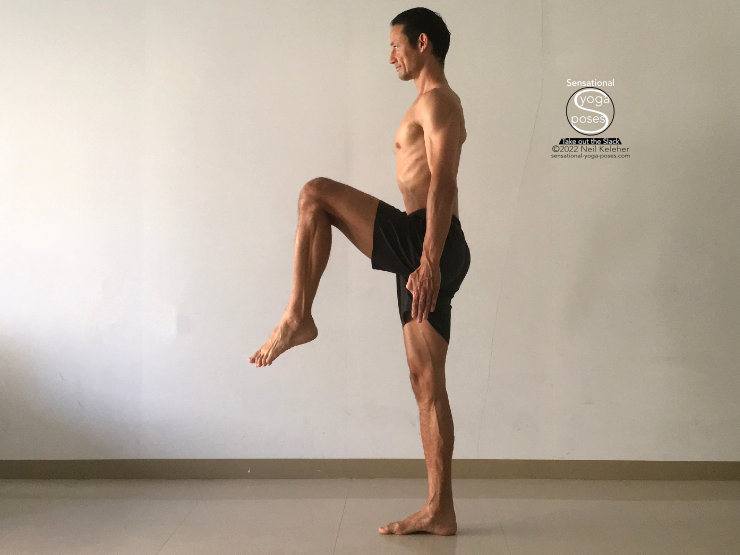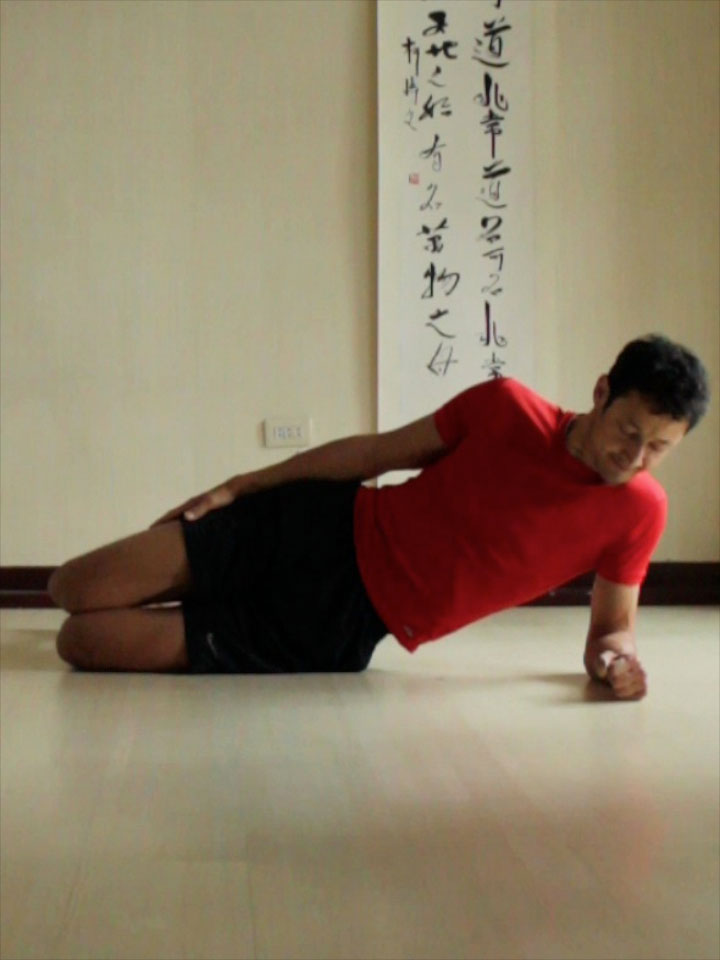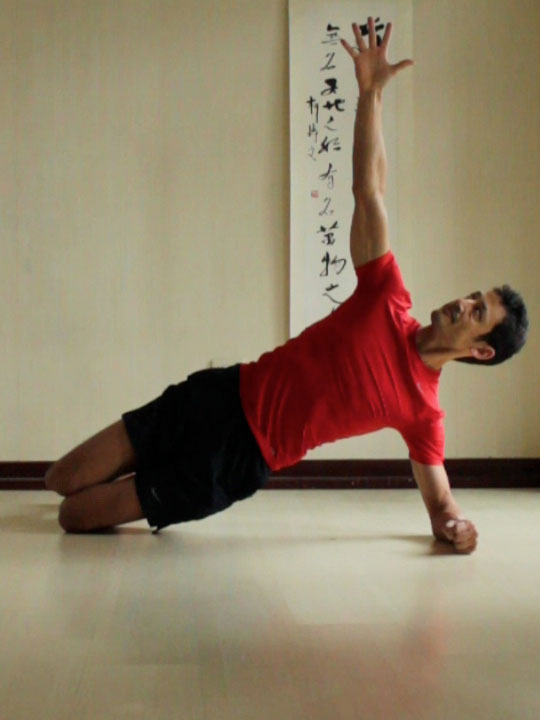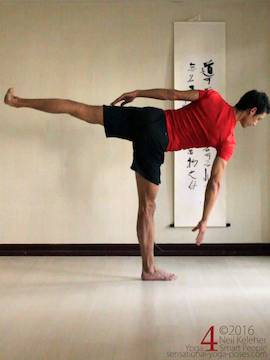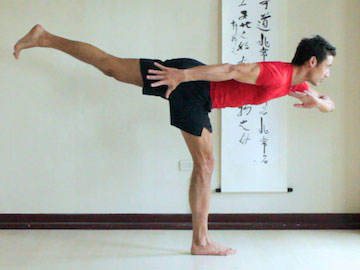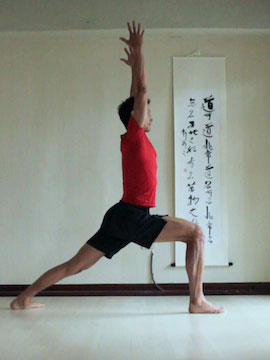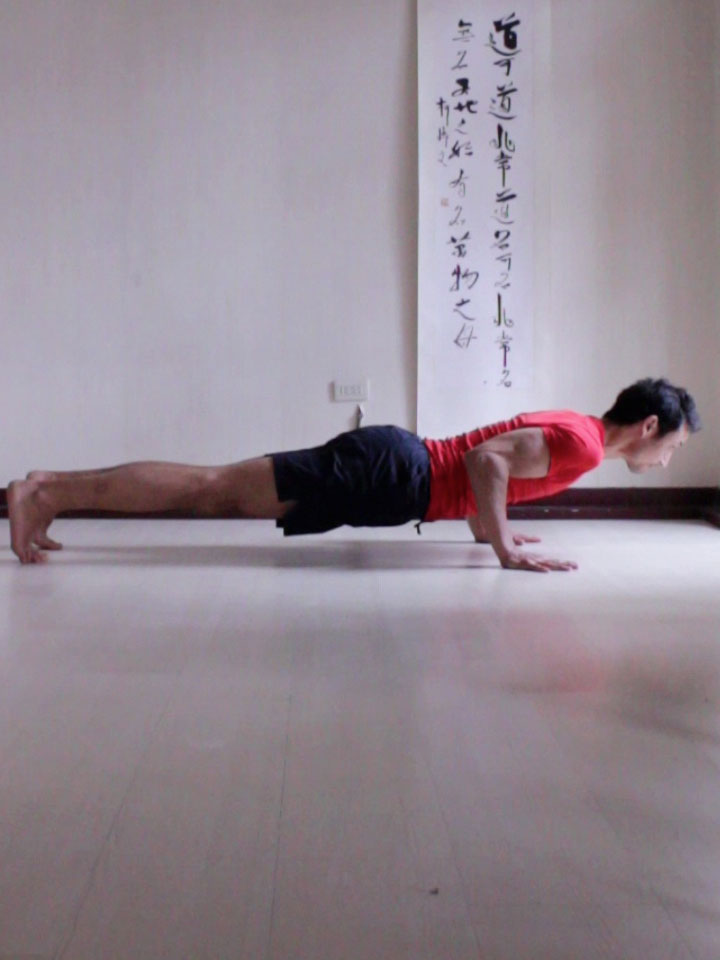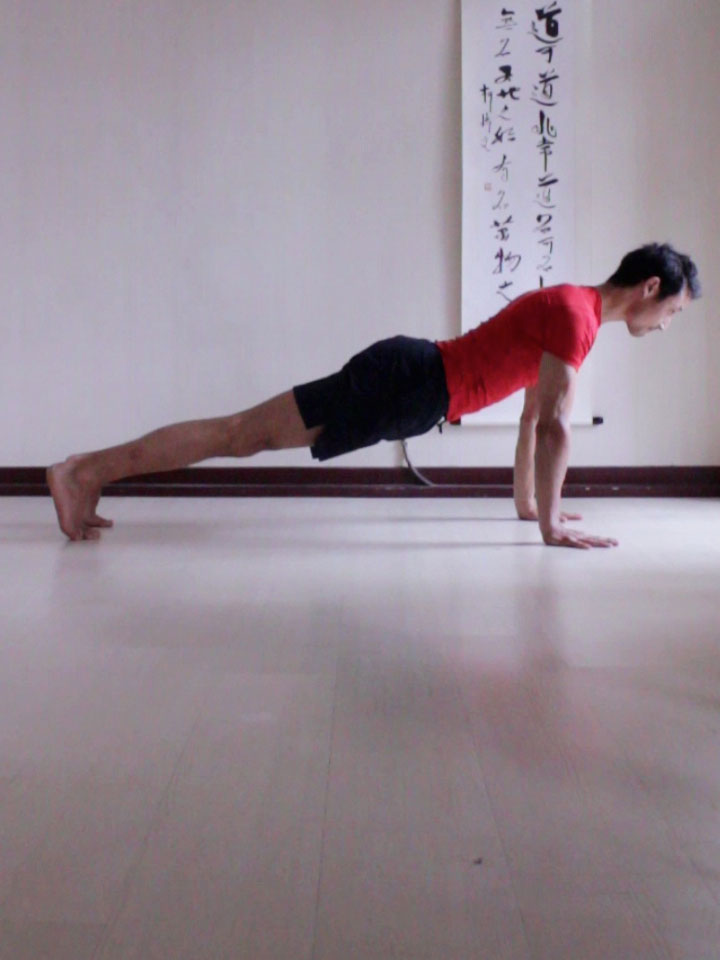Three Types of Muscular Contraction
There are three things than can happen when you engage a muscle. When activated a muscle will either
- shorten,
- remain the same length or
- lengthen.
What happens depends on the force the muscle exerts compared to the force it is working against. As an example, you could be doing a squat (with or without weight).
Starting from a standing position and slowly bending your knees, you could be using your quads to resist the bending of your knees as you hips sink downwards. You could stop with your thighs horizontal.
In the first case your quads are lengthening even though they are active. They act as brakes to slow the descent of your body. Because the force they exert is less than the weight of your body the net result is that they lengthen while active.
In the second case, pausing in the middle position, your quads are still active. However they may exert slightly more force than before because you aren't going down any deeper. And so they are active but they remain the same length.
A third case is when you straighten the legs. Now the quads are shortening while active. They exert more force than the weight of your body.
Muscular Relaxation
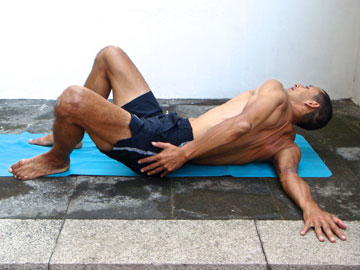
When stretching use muscle control to relax the muscles you are stretching.
When a muscle is relaxed, it generally exerts no force whatsoever.
If a muscle is relaxed you can move the bones it acts on away from each other in such a way that the muscle is lengthened.
As an example, in the Andrey Lappa shoulder stretch that I sometimes call "lappasana" you stretch the front muscles at the front of the shoulder as well as the muscles between the ribs.
The more you relax these muscles, the easier it is to move deeper into the stretch. Then when you roll out, your muscles will slowly resume their resting length.
Getting Rid of That Fragile Feeling
If you do deep stretching regularly where you focus on relaxing the muscles being stretched, you may find that you feel "fragile" afterwards.
To alleviate this feeling contract the muscles you are stretching either before you move out of the stretch (while you are still in it) or immediately after you come out of the stretch.
Another idea is to practice contracting and relaxing the muscles you are stretching as you move deeper into the stretch. Do this slowly and smoothly to prevent injury.
Keeping A Muscle Relaxed While Lengthening It
If you keep a muscle relaxed while lengthening it, you stretch the connective tissue within the muscle. This is different than lengthening a muscle while it is still engaged. However, the two can be related. You can slowly lengthen a muscle while gradually relaxing it until you reach the point where it is totally relaxed while being stretched at the same time.
Whether you relax a muscle before moving into a stretch or whether you work at relaxing it as you move into the stretch, in either case, you can practice being aware of the muscle that you want to stretch. If you find a muscle tenses up automatically as you move into the stretch you might want to change the way you move into that stretch so that you can keep it relaxed as you go into the stretch.
In a stretch like Lapassana, the muscles of the shoulder that is being stretched may automatically contract in order to prevent themselves from being over stretched.
If you move slowly and smoothly into the pose you may find that you can overcome this fear reaction.
By moving slowly into a stretch you can feel the muscle being stretched and notice when it tightens up. When it does tighten you can stop, wait, and then resume moving into the stretch when it relaxes.
Feel the Force, Know the Force
When muscles activate they create a force which pulls the bones they are attached to towards each other. (The way in which the bones move relative to each other depends on the joint or joints that the muscles acts across.)
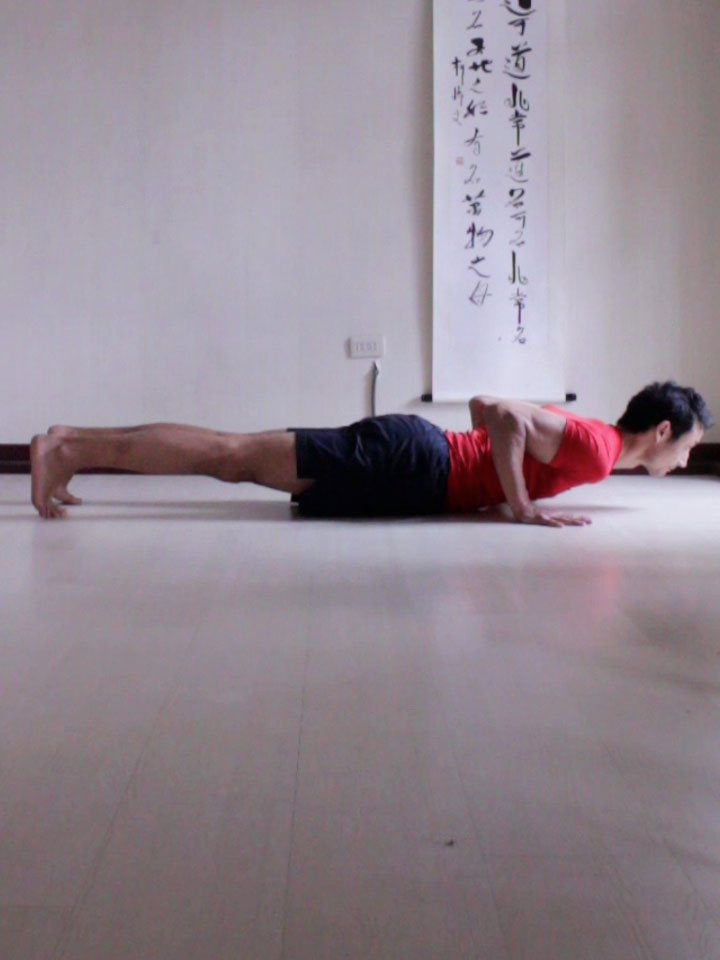
Chaturanga Dandasana
As an example, if you are holding a heavy handbag loaded with cosmetics and cold hard cash in one hand, you can use your biceps to bend your elbow and lift the bag. The heavier the bag, the more force you have to create in order to lift it.
To lift the bag your biceps has to work against both the weight of your forearm and the weight of the bag to close the front of the elbow joint.
The hand bag exerts a downward force. Via the leverage of the arms, the biceps exerts an opposing force. To lift the bag you can use your biceps to create a greater force so that the bag will lift. If you reduce the force that your arm exerts to the point that it is less than that with which the bag is pulling down then the bag will lower. By varying muscle tension you vary the force that your muscles create. You control them.
If you are laying on the ground preparing to push up into the yoga pose called Chaturanga Dandasana the muscles of your shoulders will have to create a downward force at your palms in order to lift your body up. In this case the your muscles will be working against the weight of your body.
The more you push down, the move likely you will be to lift your body off of the floor.
By feeling the force with which your hands are pressing down you can learn to sense the amount of force you are exerting. You'll be able to learn how much force you need in order to lift parts of your body off of the floor.
To reduce the amount of force that you need to use to lift your body, reduce the weight of your body. You can do this when working towards Chaturanga Dandasana by lifting only your ribcage.
Leave your pelvis on the floor!
Know Your Muscles
Side Plank (Vasisthasana) with knee and elbow bent
Another part of good muscle control is knowing where to put your awareness.
When I teach Side Plank Pose, I teach it in stages. In the first stage I have my students using their shoulder to push their ribcage up away from the floor. In order to use their shoulder (actually it's the Serratus Anterior which is being used to push the thoracic spine "away" from the shoulder blade) I have them focus on feeling their shoulder and using it to push the elbow down and the ribcage up. The shoulder is the area that they focus on.
Depending on the nature of the class and the level of the students I am working with I may actually have them practice "spreading their shoulder blades" while sitting prior to doing side plank.
Once they get the shoulder action I have them focus on using their thigh muscles to lift their pelvis. In this case it can be easier to learn with the bottom knee bent. Then when they get that they can try it with their leg straight.
The point of this exercise is to teach them where to put their awareness. Even if they don't know (or don't want to know) precisely which muscles they are using they can at least put their awareness in the general region of the muscles that they will be using so that they can focus on using those muscles. And with practice they can then consciously increase the muscular contraction so that they lift higher. They are improving their ability to control their muscles.
Using Muscle Against Muscle For Strength or Stability
1. Side Balance, 2. Warrior 3, 3. Warrior 1
With greater muscle control you can use muscles against each other. Why?
To create stability.
As an example, the muscles that act on the inside and outside edge of one ankle can be used against each other with equal force so that they stabilize your ankle joint from side to side. This can be handy if you are balancing on one foot such as in Side Balance Pose.
You could also stabilize your ankle from front to back by engaging the muscles that act on the front and back of your ankle. This too could be handy while balancing on one foot like in a pose such as in Warrior 3.
In Warrior 1 you can stabilize your ankles as above but you could also stabilize the knee and hip of your bent knee by squeezing the front of your thigh, the back the of thigh, your outer gluteals and your inner thigh muscles.
Note that in this case your thigh is already working against the weight of your body, but by adding extra contraction you increase the stability of that leg, while developing your muscle control and strength at the same time.
Fine Tuning Your Muscle Control
When doing yoga poses (or weight lifting for that matter) one of the things that you can do to develop your muscle control is to practice smoothly activating particular muscles and smoothly releasing them.
Previously I mentioned that muscle tissue can be
- engaged and shortening,
- engaged while remaining the same length,
- engaged and lengthening and
- relaxed while lengthening.
It can also be relaxed while elastically withdrawing back to its normal length.
These are extremes, or one way looking at muscle control.
To more finely tune your muscle control you can work at slowly increasing and slowly decreasing the amount of force that a muscle creates.
Going back to Chaturanga Dandasana, you can lay on the floor belly down. Feel the position of your hands, elbows and shoulders and position them so that it is as easy as possible to push downwards with your hands. Then slowly increase the pressure in your arms and press your hands into the floor. Then slowly release. At this point there is no need to worry about lifting your ribcage. Work at controlling your arm muscles and get used to using them to push your hands down. Contract and release.
Next see if you can increase the pressure and lift your ribs the tiniest amount off of the floor. Enough to slide a piece of paper between you ribs and the floor. Thats it! Then slowly lower your ribcage and relax.
Practice doing these four actions slowly and smoothly and as you do so feel the change in muscle tension in your arms.
- Press your hands into the floor to the point just before your ribcage lifts
- Lift your ribcage
- Touch your ribcage to the floor
- Relax your arms.
Once you get better at lifting and lowering your ribcage with control you may find it relatively easy to lift your pelvis and ribcage together.
Prior to that you might try lifting just your pelvis with your legs and chest on the floor. The feeling is like you are pushing your pelvis up while your ribcage and knees push down. Try this a few times and then try to do the same thing but with your ribcage lifted while using your arms. Or you could simply try using your arms to lift your ribcage and pelvis off of the floor together. You abs will more than likely automatically activate just the right amount to help you lift your ribcage and pelvis simultaneously.
Once you get the hang of that you can lift your knees also. Then you can work at lifting your whole body higher, moving up into full plank with your elbows straight.
Moving from the floor to Chaturanga Dandasana and from there to plank pose.
Published: 2020 08 17
Updated: 2021 01 28
